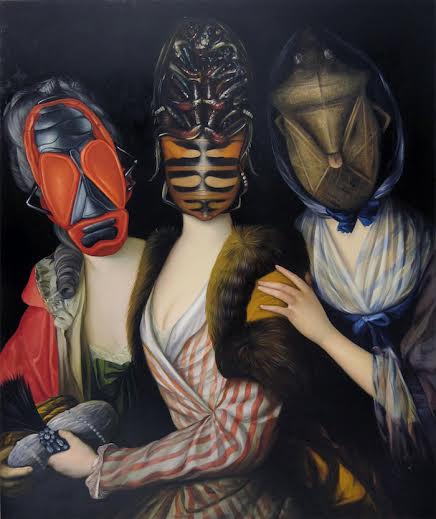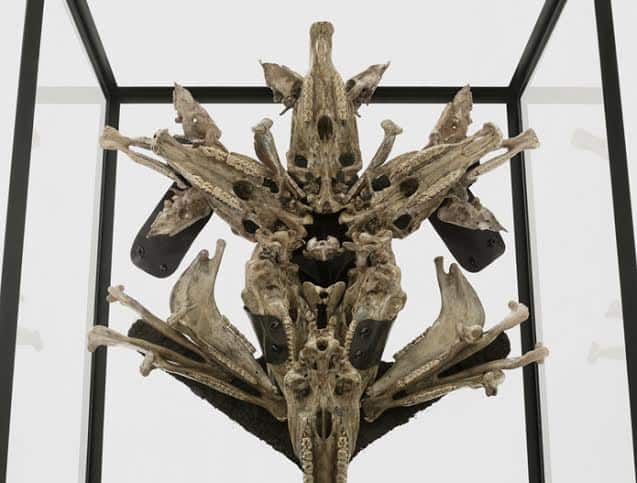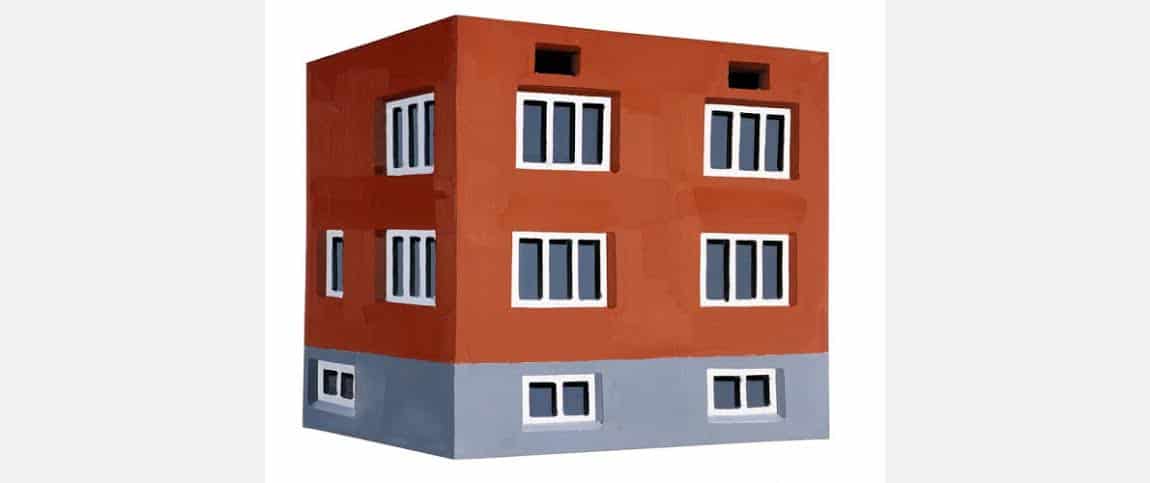The National Art Museum of China in Beijing recently held an exhibition entitled ‘The State of Life’. This vast show of Polish art after the year 1989 followed a presentation of the historical Polish art -‘Treasures from Chopin’s Country’ at the National Museum of China.
The new show of Polish contemporary art was encrusted with works by ‘early vision of modernity’ and works by Alina Szapocznikow, Katarzyna Kobro or Władysław Strzemiński. It is an attempt to re-define Polishness in the context of global culture. We all have heard about globalisation and we are all more or less conscious of all the changes it caused in our lives. We can travel, work remotely thanks to the internet, eat food from the other end of the world. Can global culture be more approachable and make art a common good to participate in? Or perhaps global culture pushes art onto the rocks of superficial understanding?

Wilhelm Sasnal, ‘Untitled’ (The Moon) 1999, oil on canvas, 60x80x3, courtesy of the artist
‘Untitled’ (‘Moon’, 1999) by Wilhelm Sasnal refers to one of the most significant events in the human history. It’s not a fine portrait of Neil Armstrong’s leg stepping on the moon – it’s rather a vague recollection of a memorable event taken from a storage of collective memory, preserved so well in countless copies reproduced over the years. Here, one man’s step focused the attention of many. It’s true that the conquest of space, albeit being a political matter and a demonstration of power in most cases, also embodies everyone’s one common dream: to discover the unknown Universe. The first missions to explore space coincided with the new media rising – the TV was on. Today’s information flow is wider and faster. It reaches places which a decade ago were out of the loop. What fifty years ago allowed people to participate in one of the greatest events ever, today turned into an overwhelming flow which plunged us with too much. From this point of view, certain ideas or rather products are known globally. Does it mean that we are a part of a global culture or rather a global economy driven by/with pop culture, celebritism and endlessly multiplied craved information?
Considering daily routines of Europeans and Chinese few differences could be spotted. We are all different, as the wise man said, and so are our mentalities and habits. Daily routines shape our lives. As Europe seems to be intoxicated with globalism, in China local aspects of life remain more vital. Morning Tai-Chi session, group dancing, meetings over the pop-up barbecues set on the streets of suburbs, children playing on squares. Here it’s unlikely that either Starbucks or H&M will take over five thousand years of cultural continuity.
Yet, according to the Financial Times lexicon definition: globalism after the 1989 was strictly connected to economy but more recently the term has been expanded to include a broader range of areas and activities such as culture, media, technology, socio-cultural, political, and even biological factors, e.g. climate change. Globalisation describes a process by which national and regional economies, societies, and cultures have become integrated through the global network of trade, communication, immigration and transportation.
The curator of the exhibition – Jarosław Lubiak – within the show recalls an idea by Hans Belting to whom contemporary art is identical with a global art. Modern art was all about political and cultural domination of Western Europe, United States. Contemporary art, thanks to globalisation, is able not only to appear and exist on previously culturally deserted areas but it’s also no longer controlled by the Western powers, Belting claims. His idea of the art world decentralization and art prevalence now means common and unstoppable process of image and information copying. Economy feeds on high incomes and global reach, yet people feel cosier not in the mainstream but on its margins, on the locally tailored self-sufficient islands.

Ewa Juszkiewicz, ‘Sisters’, 2014, oil on canvas, 142 x 116cm, courtesy of the artist
‘Sisters’ (2012) by Ewa Juszkiewicz depicts three women in funny masks. It would be a good illustration of the global culture or, to be more accurate, a global way of being. Seemingly attractive outfits turn into incomprehensible disguises impossible to read. It’s a fact that fashion along with celebrities entered the high art. It brought about bizarre-ness and decadence reviled in vast art productions, often turned art exhibitions in mass events.
Global ‘cultural’ way of being can be easily mistaken with art qualities and ideas which make art a universal language. Does global culture based on prevalence and extensive consumption of goods give us the tools to broaden and deepen the perception of art?

Janek Simon, ‘State Budget for the 2010’, (fragment), courtesy of the artist, photo Kuba Budzynsky, 2015
That is why Jarosław Lubiak touches upon the weak points of Polishness. He appeals to the atavistic need of overcoming difficulties by putting social-economical changes in the context of individual persona. He refers to common ground of experiences such us fear, confusion and anxiety which accompanies a transformation process. In the face of all events, either significant or ordinary ones, only the single participant matters. Obviously, without the participant it would have a different philosophical undertone. From this perspective economical facts appear differently. Janek Simon displayed the ‘State Budget for the 2010’ as a three dimensional installation assembled of stripes of joyful colours. We can only guess how little an everyman would understand from it and more importantly what would politicians and economists care about it. From an economic perspective, globalisation disturbed geopolitical seclusion of countries.

Włodzimierz Pawlak, ‘Nostalgia’, 1986, courtesy of the artist
The show opened with works referring to Polishness and its symbols, which in the past was traditionally connected to a motto: God, honour, homeland. It strictly refers to a state, its territory, language, history and tradition. ‘Nostalgia’ (1986) a painting by Włodzimierz Pawlak which depicts a lying-flying character on the white-red background representing the Polish flag confronts traditional approach to the Polish virtues. We are no longer sure if the person on the painting swims in Polishness or rather drifts in a void.
Polish tradition read by its symbols might be considered as a difficult task in China, the country where Christ remains an unknown historical character and the cross resembles Chinese character for number ten rather than the redemption of sins, which would be rather difficult to sympathise with to a Chinese art viewer.
If Polishness could be materialized in only one genre of painting it would be a landscape. At the turn of 19th and 20th centuries Witold Wojtkiewicz, Ferdynand Ruszczyc, Józef Pankiewicz, put acres of longing and sentiments for freedom in their paintings. They dreamt about it and painted Polish ponds filled with carps, weeping willows, everlasting sunsets, light frosted birches and fool moon nights in orchards. Leon Tarasewicz continued this romantic vision of nature which embodies an essence of homeland. This particular idea is very vivid in his early paintings such us black and white landscape, (‘Untitled’, 1987).
Freedom after the war brings about hope and joy but also a great deal of trauma. Andrzej Wróblewski dealt exceptionally well with this subtle yet serious matter. Characters from his paintings freeze in silence to process their sorrows in seclusion. In ‘Zakochani’ (‘Lovers’, 1957) it’s clear that the first love is stigmatized with a great deal of sadness. Painting became a pictorial way to process post-war traumas which everyone needs to confront separately.

Jan Manski, ‘Triumphant’, 2010, courtesy of the artist
Jan Manski experienced the 1989 breakthrough as a child. The Second World War experiences were only a vague shadow of memories to him. In his work ‘Triumphant’ (2010) which is a part of a series ‘Posessia’ he refers to Nazism and brings about an analysis of violence by exposing its vitality.
To build a new future in Communism meant new architecture capable of facing the great need of cheap accommodation for working class people embodied in a rich variety of blocks of flats. The most surreal of them are the ones built in late 60s and 70s in Gdansk. These long, wavy-shaped, ten floor high structures managed to fit up to 6,000 apartments. It’s difficult to say if Julita Wójcik’s work ‘Falowiec’ (‘Waver’, 2005-2006) – a knitted cover made by the artists – expresses her revolt and desire to hide the building’s ugliness or, perhaps, it’s to protect this mighty prop straight from her childhood memories.

Nicolas Grospierre, ‘Kolorobloki’, 2006, courtesy of BWA WARSZAWA Gallery
Contrary to Julita Wójcik Polishness sealed in the architecture of this era, work by Nicolas Grospierre brings a cold-eyed perspective to it. In series of photographs ‘Kolorobloki’ (2006) he carefully analyses how turns of socialism had satiated architecture of this era. From psychological point of view we resonate with what is familiar to us. I am guessing that city-landscapes from Wójcik and Grospierre’s works plus Rafał Bujnowski in ‘Graboszyce’ (2002) might interest Chinese art viewers a lot. Beijing is a metropolis inhabited by 20 million people – the equivalent of half of Poland. It’s stuffed with architecture in larger scale and quantity yet disturbing similarly to ‘Falowiec’ (‘Waver’).
It is certain that figurative and literal landscapes of Polishness would resonate with the experiences of the audiences in Beijing. Does it mean that Polish art is more global than local? We need to ask the Chinese about that.
Words: Monika Waraxa
‘State of Life’ – Polish Contemporary Art in Beijing
10/05–24/06/2015
National Art Museum of China, 1 Wusi Dajie, East District

Rafał Bujnowski, ‘Graboszyce’, 2002, oil on canvas,75 x 89 x 3,5 cm, courtesy of the artist






